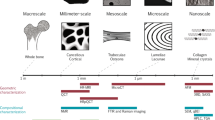Abstract
Theoretically determined mass attenuation coefficients for different bone mineral substitute materials together with values for water and fat are tabulated. The use of hydroxyapatite as a synonym for bone mineral is proposed. The abbreviation BMA (bone mineral areal mass) is suggested for use in conjunction with the unit g/cm2. Suggestions are also made for other quantities and units for use in reports of bone mineral measurements.
Similar content being viewed by others
References
Kalender W, Felsenberg D, Arkadiusz P, et al. A cross-calibration phantom for spinal bone mineral measurements in a multicenter study. Commission of the European Communities, 1st European conference on biomedical engineering, 1991:76–7.
Berger MJ, Hubbell JH. XCOM: photon cross sections on a personal computer. National Bureau of Standards Report NBSIR 87-3597, 1987.
Hubbell JH, Veigele WJ, Briggs EA, Brown RT, Cromer DT, Howerton RJ. Atomic form factors, incoherent scattering functions and photon scattering cross sections. J Phys Chem Ref Data 1975;4:471–538, erratum in 1977;6:615–6.
Hubbell JH, Overbo I. Relativistic atomic form factors and photon coherent scattering cross sections. J Phys Chem Ref Data 1979;8:69–105.
Scofield JH. Theoretical photoionization cross sections from 1 to 1500 keV. Lawrence Livermore National Laboratory Report UCRL-51326, 1973.
ICRP publication 23: Report of the task group on Reference Man. Oxford: Pergamon Press, 1975.
White DR. Tissue substitutes in experimental radiation physics. Med Phys 1978;5:467–9.
Goodsitt MM. Evaluation of a new set of calibration standards for the measurement of fat content via DPA and DXA. Med Phys 1992;19:35–44.
Yang NC, Leichner PK, Hawkins WG. Effective atomic numbers for low-energy total photon interactions in human tissues. Med Phys 1987;14:759–66.
McLean FC, Urist MR. Bone 3rd ed. Chicago: University of Chicago Press, 1968.
Weast RC, ed. CRC handbook of chemistry and physics. 62nd ed. Florida: Chemical Rubber Publishing Company, 1983:B228–9.
Blake GM, McKeeney DB, Chhaya C, Ryan PJ, Fogelman I. Dual energy X-ray absorptiometry: the effects of beam hardening on bone density measurements. Med Phys 1992;19:495–65.
Wilson CR, Collier BD, Carrera GF, et al. Acronym for dual-energy X-ray absorptiometry. Radiology 1990;176:875.
Ho CP, Kim RW, Schaffler MB, Sartoris DJ. Accuracy of dual-energy radiographic absorptiometry of the lumbar spine: cadaver study. Radiology 1990;176:171–3.
Author information
Authors and Affiliations
Rights and permissions
About this article
Cite this article
Jonson, R. Mass attenuation coefficients, quantities and units for use in bone mineral determinations. Osteoporosis Int 3, 103–106 (1993). https://doi.org/10.1007/BF01623381
Received:
Accepted:
Issue Date:
DOI: https://doi.org/10.1007/BF01623381




